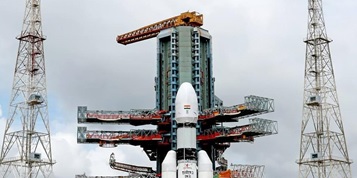13 October, 2025
CMS-03 Satellite
Tue 28 Oct, 2025
Introduction
The Indian Space Research Organisation (ISRO) is all set to launch the CMS-03 Satellite, also known as GSAT-7R, from the Satish Dhawan Space Centre, Sriharikota. This launch marks another milestone in India’s growing self-reliance in space-based communication technology. The CMS-03 satellite, primarily a military communication satellite, is designed to enhance India’s secure communication network for defence, maritime, and strategic users.
About CMS-03 Satellite
The CMS-03 (Communication Satellite 03) is part of India’s advanced communication satellite series and is the successor to GSAT-7A and GSAT-7B satellites, which serve the Indian Navy and Air Force, respectively.
It is also known as GSAT-7R, where the “R” stands for “replacement” — replacing older communication systems with upgraded and high-capacity networks.
The satellite weighs around 4,400 kilograms, making it the heaviest communication satellite to be launched by ISRO. It is designed to function as a multi-band communication satellite, capable of transmitting secure, high-quality data and signals over a wide oceanic region, including the entire Indian landmass.
Launch Vehicle and Orbit
The CMS-03 will be launched aboard Launch Vehicle Mark-3 (LVM3) — ISRO’s most powerful and reliable heavy-lift launch vehicle.
- Orbit Type: Geosynchronous Transfer Orbit (GTO)
- Final Position: Geosynchronous Orbit (GSO)
The satellite will be positioned in a Geosynchronous Orbit, a high Earth orbit where the satellite moves in the same direction as Earth’s rotation. From this orbit, it will appear to remain stationary relative to a fixed longitude on Earth. This ensures continuous coverage and communication connectivity for specific geographic zones, which is crucial for strategic operations.
This orbit is also called the Clarke Orbit, named after the British science fiction writer Arthur C. Clarke, who first popularized the concept in 1945.
Strategic Importance
The CMS-03 is part of India’s ongoing efforts to modernize and secure communication infrastructure for its armed forces and strategic establishments.
1. Defence Communication:
The satellite will provide high-bandwidth, secure communication for the Indian Navy, Air Force, and Army, ensuring real-time data and command transmission in sensitive areas.
2. Maritime Surveillance:
It will extend coverage over the Indian Ocean Region (IOR), enhancing maritime domain awareness, naval operations, and coordination during strategic missions.
3. Civil and Strategic Applications:
Apart from defence, CMS-03 will also support communication for disaster management, remote sensing, and telecommunication services across remote and border areas.
4. Self-Reliance in Strategic Communications:
With CMS-03, India reduces dependency on foreign satellites for defence communication — a critical step under the ‘Atmanirbhar Bharat in Space Technology’ initiative.
Technical Features
| Parameter | Details |
| Name | CMS-03 (GSAT-7R) |
| Launched by | ISRO |
| Launch Vehicle | LVM3 (Launch Vehicle Mark-3) |
| Launch Site | Satish Dhawan Space Centre, Sriharikota |
| Weight | ~4400 kg |
| Orbit Type | Geosynchronous Transfer Orbit (GTO) |
| Coverage Area | Indian subcontinent and adjoining oceanic region |
| Primary Users | Defence, Maritime, Strategic, and Civil sectors |
| Special Feature | Multi-band, high-capacity, encrypted communication links |
Significance for India’s Space and Defence Program
- Enhanced Defence Readiness: CMS-03’s advanced communication technology will provide uninterrupted, secure connectivity even in remote and oceanic areas.
- Boost to Strategic Autonomy: With its deployment, India joins the league of nations capable of launching and operating heavy-duty military communication satellites.
- Supports Maritime Security: Strengthens India’s operational presence across the Indian Ocean Region, complementing the Navy’s network-centric operations.
- Space Innovation: Demonstrates ISRO’s growing competence in designing dual-use (civil + military) space assets for integrated national development.
Conclusion
- The CMS-03 (GSAT-7R) satellite represents a critical step in India’s space-based defence communication architecture. By combining cutting-edge communication systems with indigenous launch capabilities, ISRO continues to reinforce India’s standing as a space and strategic power.
- The mission not only enhances defence preparedness but also supports India’s long-term vision of becoming self-reliant in advanced space technologies.
- This launch is a testimony to India’s technological innovation, strategic foresight, and the continuous effort to ensure that its armed forces and critical sectors remain connected, informed, and future-ready.


















